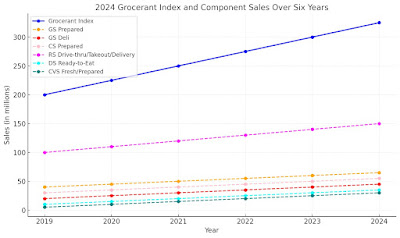In
the ever-evolving food industry, pricing strategy remains the cornerstone of
profitability and consumer loyalty. Today, a new player has entered the pricing
arena: algorithmic pricing another technology solutions that according
to Steven Johnson
Grocerant Guru® at Tacoma, WA based Foodservice Solutions®
will have as many pitfalls as benefits in the beginning.
Algorithmic
pricing is the automated process of setting
product prices using artificial intelligence, big data, and real-time
analytics. It dynamically adjusts prices based on factors like consumer
behavior, inventory levels, competitor pricing, time of day, and even weather.
While
big tech has already revolutionized online shopping, the food industry—from
grocery stores and convenience stores to restaurants—is beginning to embrace
algorithmic pricing. But the question is: Will algorithmic pricing help or
hurt food retailers?
Let’s
break it down.
3 Ways Algorithmic Pricing Will Help Food Retailers
1. Optimized
Profit Margins
Grocery stores and C-stores operate on razor-thin margins—often less than 2%.
Algorithmic pricing helps optimize pricing in real time to protect margins
without alienating customers. For example, pricing high-demand items slightly
higher during peak times can generate incremental revenue without a full-blown
price hike.
2. Reduced
Waste & Improved Inventory Turnover
For perishables like produce or fresh food in restaurants, algorithms can lower
prices to accelerate sales before expiration. C-stores can reduce food waste by
adjusting sandwich prices toward the end of the day. It’s a win for
sustainability and the bottom line.
3. Competitive
Advantage Through Real-Time Data
Retailers can instantly adjust to competitor promotions or market shifts. A
grocery chain using algorithmic pricing can match or beat nearby store pricing
in minutes—not days. Restaurants can dynamically price combo meals during
slower hours to increase traffic and ticket size.
5 Ways Algorithmic Pricing May Offend Consumers
1. Perceived
Unfairness
Customers may feel cheated if prices vary significantly for the same product
based on time, location, or device. A breakfast sandwich at 8 AM might cost
more than at 10 AM—not because it’s fresher, but because the algorithm says so.
That can lead to customer mistrust.
2. Loss
of Price Transparency
Frequent, unpredictable changes in price can confuse or frustrate shoppers.
Loyalty is often built on trust and predictability—two things dynamic pricing
can erode.
3. Digital
Discrimination
Pricing based on browsing history, zip code, or income level can
unintentionally reinforce economic disparity. A consumer in an affluent
neighborhood might consistently see higher prices, feeding a narrative of price
gouging.
4. Damage
to Brand Integrity
Restaurants and C-stores that position themselves as "value-driven"
risk appearing opportunistic if prices vary widely. A value menu can’t
fluctuate without losing its brand promise.
5. Social
Media Blowback
Angry customers who notice price discrepancies might air grievances online. A
viral tweet showing two receipts for the same burger at different prices could
cause reputational damage.
Think About This from The Grocerant Guru®
Let’s
get real: algorithmic pricing can help chains and retailers compete at
scale. In regional or national markets, these tools provide agility, especially
when battling discounters like Walmart or fast-casual juggernauts like
Chipotle. In that sense, it levels the playing field.
But
here’s the flip side—when it comes to one-on-one interactions with the
consumer, algorithmic pricing risks widening the trust gap.
We’re
already living in a world where personalized pricing borders on personalized
discrimination. If two customers walk into the same restaurant and pay
different prices for the same meal based on a machine’s decision, the human
relationship with the brand begins to fracture.
Grocers, C-stores, and restaurant operators must balance efficiency with empathy. Just because an algorithm can change the price in real time doesn’t mean it should—especially if it offends the very customers it’s designed to serve.
Algorithmic pricing is a powerful tool—but like all tools, it depends on how
it’s used. For food retailers, success lies not just in capturing revenue, but
in maintaining consumer trust and delivering value consistently.
Retailers must tread carefully or risk trading short-term gains for long-term
brand erosion.
Let’s Build a Partnership for Growth
Looking
for the right partner to drive sales and amplify your marketing
impact? Success leaves clues—and we may have the exact insight you
need to propel your business forward.
Explore
innovative food marketing and business development strategies with Foodservice
Solutions®.
📩
Contact us at Steve@FoodserviceSolutions.us
🔍 Learn more at GrocerantGuru.com






.jpg)
No comments:
Post a Comment